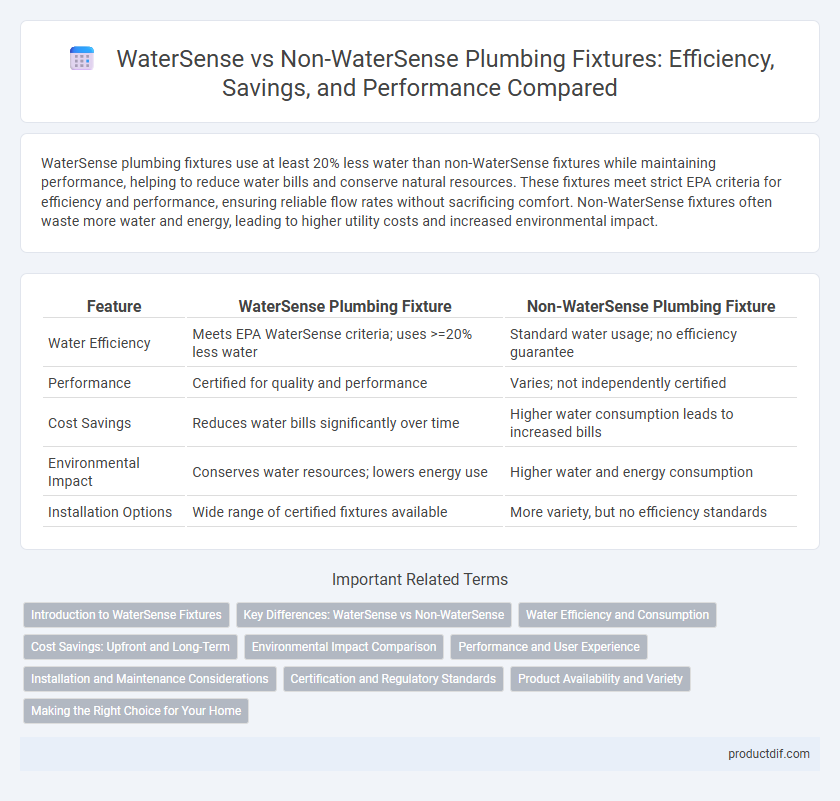WaterSense plumbing fixtures use at least 20% less water than non-WaterSense fixtures while maintaining performance, helping to reduce water bills and conserve natural resources. These fixtures meet strict EPA criteria for efficiency and performance, ensuring reliable flow rates without sacrificing comfort. Non-WaterSense fixtures often waste more water and energy, leading to higher utility costs and increased environmental impact.
Table of Comparison
| Feature | WaterSense Plumbing Fixture | Non-WaterSense Plumbing Fixture |
|---|---|---|
| Water Efficiency | Meets EPA WaterSense criteria; uses >=20% less water | Standard water usage; no efficiency guarantee |
| Performance | Certified for quality and performance | Varies; not independently certified |
| Cost Savings | Reduces water bills significantly over time | Higher water consumption leads to increased bills |
| Environmental Impact | Conserves water resources; lowers energy use | Higher water and energy consumption |
| Installation Options | Wide range of certified fixtures available | More variety, but no efficiency standards |
Introduction to WaterSense Fixtures
WaterSense fixtures are plumbing products certified by the Environmental Protection Agency (EPA) for water efficiency and performance, reducing water use by at least 20% compared to standard non-WaterSense fixtures. These fixtures include faucets, showerheads, and toilets designed to maintain high functionality while conserving water. Choosing WaterSense fixtures helps lower water bills and supports sustainable water management efforts.
Key Differences: WaterSense vs Non-WaterSense
WaterSense fixtures are certified to meet the U.S. Environmental Protection Agency's water efficiency and performance criteria, using at least 20% less water than standard non-WaterSense products. Non-WaterSense fixtures often lack this certification, typically consuming more water and contributing to higher utility bills and environmental impact. The key differences center on water conservation, performance standards, and long-term cost savings for consumers.
Water Efficiency and Consumption
WaterSense plumbing fixtures reduce water consumption by at least 20% compared to non-WaterSense fixtures, promoting efficient water use without sacrificing performance. These fixtures undergo rigorous testing to ensure they meet EPA criteria, significantly lowering household water wastage and utility costs. Non-WaterSense fixtures typically consume more water, leading to higher utility bills and increased environmental impact due to inefficient water usage.
Cost Savings: Upfront and Long-Term
WaterSense plumbing fixtures typically cost 10-20% more upfront than non-WaterSense fixtures due to advanced water-saving technology. However, WaterSense fixtures reduce water consumption by at least 20%, leading to significant long-term savings on utility bills that often offset initial costs within 1-2 years. Over the fixture's lifespan, households can save hundreds of dollars while contributing to water conservation efforts.
Environmental Impact Comparison
WaterSense fixtures use at least 20% less water than non-WaterSense fixtures, significantly reducing water consumption and contributing to sustainable water management. Non-WaterSense fixtures typically lead to higher water usage, increasing the strain on local water supplies and energy resources used for water heating. Choosing WaterSense products minimizes environmental impact through decreased water waste and lower energy emissions associated with water processing and heating.
Performance and User Experience
WaterSense plumbing fixtures achieve up to 20% water savings compared to non-WaterSense models by using advanced flow control technology without sacrificing pressure or functionality. Users report enhanced comfort and consistent performance due to optimized aerators and valves that maintain strong, even water streams. Non-WaterSense fixtures often consume more water and may deliver uneven flow, leading to decreased user satisfaction and higher utility costs.
Installation and Maintenance Considerations
WaterSense fixtures typically require similar installation steps as non-WaterSense models but often include advanced designs that simplify leak prevention and reduce water waste, leading to easier long-term maintenance. Non-WaterSense fixtures may involve more frequent adjustments and repairs due to less efficient flow control, increasing overall maintenance efforts. Choosing a WaterSense fixture can result in lower utility bills and fewer plumbing issues, optimizing both installation efficiency and upkeep costs.
Certification and Regulatory Standards
WaterSense fixtures meet strict EPA certification requirements, ensuring at least 20% greater water efficiency compared to standard plumbing fixtures without compromising performance. Non-WaterSense fixtures lack this certification and often fail to comply with current regulatory water conservation standards, potentially resulting in higher water usage and increased utility costs. Selecting WaterSense-certified faucets, showerheads, and toilets supports compliance with the Energy Policy Act (EPACT) and local plumbing codes that promote sustainable water management.
Product Availability and Variety
WaterSense fixtures offer a wide range of products designed for water efficiency, including faucets, showerheads, and toilets, making them readily available across major home improvement retailers and online platforms. Non-WaterSense fixtures often provide a broader variety of styles and functionalities but lack standardized water-saving certification. Consumers seeking environmentally friendly and cost-effective plumbing options benefit from the extensive selection of certified WaterSense products without compromising on design or performance.
Making the Right Choice for Your Home
WaterSense fixtures use at least 20% less water than non-WaterSense fixtures without sacrificing performance, making them an efficient choice for reducing water bills and conserving resources. Non-WaterSense fixtures often lack the technology to limit flow rates, leading to higher water consumption and increased utility costs over time. Choosing WaterSense-certified plumbing fixtures ensures optimal water efficiency while maintaining reliable functionality for your home.
WaterSense fixture vs Non-WaterSense fixture Infographic

 productdif.com
productdif.com